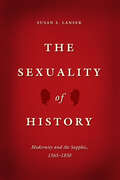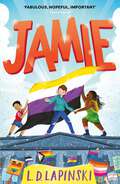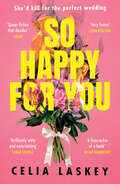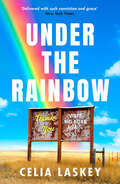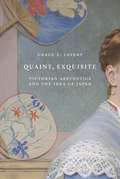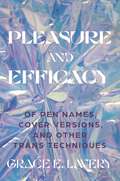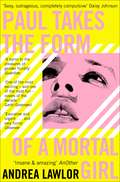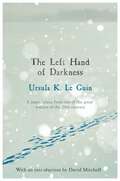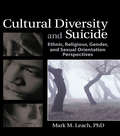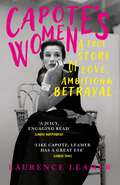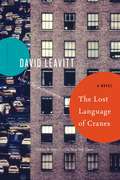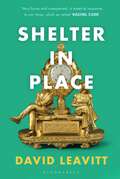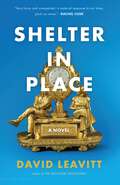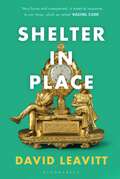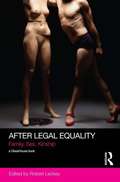- Table View
- List View
The Sexuality of History: Modernity and the Sapphic, 1565-1830
by Susan S. LanserThe period of reform, revolution, and reaction that characterized seventeenth- and eighteenth-century Europe also witnessed an intensified interest in lesbians. In scientific treatises and orientalist travelogues, in French court gossip and Dutch court records, in passionate verse, in the rising novel, and in cross-dressed flirtations on the English and Spanish stage, poets, playwrights, philosophers, and physicians were placing sapphic relations before the public eye. In The Sexuality of History, Susan S. Lanser shows how intimacies between women became harbingers of the modern, bringing the sapphic into the mainstream of some of the most significant events in Western Europe. Ideas about female same-sex relations became a focal point for intellectual and cultural contests between authority and liberty, power and difference, desire and duty, mobility and change, order and governance. Lanser explores the ways in which a historically specific interest in lesbians intersected with, and stimulated, systemic concerns that would seem to have little to do with sexuality. Departing from the prevailing trend of queer reading whereby scholars ferret out hidden content in “closeted” texts, Lanser situates overtly erotic representations within wider spheres of interest. The Sexuality of History shows that just as we can understand sexuality by studying the past, so too can we understand the past by studying sexuality.
The Sexuality of History: Modernity and the Sapphic, 1565-1830
by Susan S. LanserThe period of reform, revolution, and reaction that characterized seventeenth- and eighteenth-century Europe also witnessed an intensified interest in lesbians. In scientific treatises and orientalist travelogues, in French court gossip and Dutch court records, in passionate verse, in the rising novel, and in cross-dressed flirtations on the English and Spanish stage, poets, playwrights, philosophers, and physicians were placing sapphic relations before the public eye. In The Sexuality of History, Susan S. Lanser shows how intimacies between women became harbingers of the modern, bringing the sapphic into the mainstream of some of the most significant events in Western Europe. Ideas about female same-sex relations became a focal point for intellectual and cultural contests between authority and liberty, power and difference, desire and duty, mobility and change, order and governance. Lanser explores the ways in which a historically specific interest in lesbians intersected with, and stimulated, systemic concerns that would seem to have little to do with sexuality. Departing from the prevailing trend of queer reading whereby scholars ferret out hidden content in “closeted” texts, Lanser situates overtly erotic representations within wider spheres of interest. The Sexuality of History shows that just as we can understand sexuality by studying the past, so too can we understand the past by studying sexuality.
The Sexuality of History: Modernity and the Sapphic, 1565-1830
by Susan S. LanserThe period of reform, revolution, and reaction that characterized seventeenth- and eighteenth-century Europe also witnessed an intensified interest in lesbians. In scientific treatises and orientalist travelogues, in French court gossip and Dutch court records, in passionate verse, in the rising novel, and in cross-dressed flirtations on the English and Spanish stage, poets, playwrights, philosophers, and physicians were placing sapphic relations before the public eye. In The Sexuality of History, Susan S. Lanser shows how intimacies between women became harbingers of the modern, bringing the sapphic into the mainstream of some of the most significant events in Western Europe. Ideas about female same-sex relations became a focal point for intellectual and cultural contests between authority and liberty, power and difference, desire and duty, mobility and change, order and governance. Lanser explores the ways in which a historically specific interest in lesbians intersected with, and stimulated, systemic concerns that would seem to have little to do with sexuality. Departing from the prevailing trend of queer reading whereby scholars ferret out hidden content in “closeted” texts, Lanser situates overtly erotic representations within wider spheres of interest. The Sexuality of History shows that just as we can understand sexuality by studying the past, so too can we understand the past by studying sexuality.
The Sexuality of History: Modernity and the Sapphic, 1565-1830
by Susan S. LanserThe period of reform, revolution, and reaction that characterized seventeenth- and eighteenth-century Europe also witnessed an intensified interest in lesbians. In scientific treatises and orientalist travelogues, in French court gossip and Dutch court records, in passionate verse, in the rising novel, and in cross-dressed flirtations on the English and Spanish stage, poets, playwrights, philosophers, and physicians were placing sapphic relations before the public eye. In The Sexuality of History, Susan S. Lanser shows how intimacies between women became harbingers of the modern, bringing the sapphic into the mainstream of some of the most significant events in Western Europe. Ideas about female same-sex relations became a focal point for intellectual and cultural contests between authority and liberty, power and difference, desire and duty, mobility and change, order and governance. Lanser explores the ways in which a historically specific interest in lesbians intersected with, and stimulated, systemic concerns that would seem to have little to do with sexuality. Departing from the prevailing trend of queer reading whereby scholars ferret out hidden content in “closeted” texts, Lanser situates overtly erotic representations within wider spheres of interest. The Sexuality of History shows that just as we can understand sexuality by studying the past, so too can we understand the past by studying sexuality.
Jamie: A joyful story of friendship, bravery and acceptance
by L.D. Lapinski'FABULOUS, HOPEFUL, IMPORTANT' - Emma CarrollA beautiful and uplifting story from L.D. Lapinski, author of The Strangeworlds Travel Agency, about how to make your own place when the world doesn't think you fit anywhere. For fans of Me, My Dad and The End of The Rainbow.Jamie Rambeau is a happy 11-year-old non-binary kid who likes nothing better than hanging out with their two best friends Daisy and Ash. But when the trio find out that in Year Seven they will be separated into one school for boys and another for girls, their friendship suddenly seems at risk. And when Jamie realises no one has thought about where they are going to go, they decide to take matters into their own hands, and sort it all out once and for all.As the friends' efforts to raise awareness eventually become a rooftop protest against the binary rules for the local schools, Jamie realises that if they don't figure out a way forwards, they might be at risk of losing both their friends forever...
The Thousand Eyes (The Serpent Gates #2)
by A. K. LarkwoodBrilliant, bold and thrilling, The Thousand Eyes by A. K. Larkwood is the epic fantasy sequel to The Unspoken Name.Could you sacrifice your dreams to escape a nightmare?Csorwe, Shuthmili and Tal survey abandoned Echentyr worlds to make a living. The empire’s ruins seem harmless but fascinating. Yet disaster strikes when they stumble upon ancient magic during a routine expedition. This revives a warrior who’d slept for an age, reigniting a conflict thousands of years old. And the soldier binds Csorwe to her cause. Shuthmili is desperate to protect the woman she loves. However, as events escalate, she’s torn. Can she help Csorwe by clinging to her own humanity or by embracing her eldritch powers?Tal heads home, but his peace is shattered when a magical catastrophe hits his city. The wizard Sethennai is missing and Tal can’t face seeking his former lover to ask for help. So, he flees – but there’s no escaping the future. For throughout the Echo Maze’s linked worlds, fragments of an undead goddess are waking. Soon all must choose a side. Praise for The Unspoken Name: ‘An outstanding debut . . . unlike anything I’ve read before’ – Nicholas Eames ‘Richly detailed, enthralling and extraordinary’ – Jenn Lyons ‘Stylish, classy and timeless . . . I cannot recommend it enough’ – Tamsyn Muir‘An adventure I couldn’t put down’ – S. A. Chakraborty
So Happy For You
by Celia LaskeyBridesmaids meets Black Mirror in the most twisted and entertaining thriller of 2022. ‘Brilliantly witty and entertaining’ Sarah Stovell, author of Other Parents ‘A firecracker of a book’ Micah Nemerever, author of These Violent Delights
Under the Rainbow
by Celia Laskey‘Laskey is a talented, sharp writer and her debut novel has its fingers on the pulse of the human condition’ Kristen Arnett, author of The New York Times-bestseller Mostly Dead Things ‘Refreshing, smartly executed and often very funny’ Mail Online
Surviving Transphobia
by Laura A. Jacobs, Lcsw-R, EditorThe transgender and gender nonbinary community is forever under siege. Institutional transphobia is enacted by those who would return us to the shadows, the closets, or worse. Surviving Transphobia is an anthology by transgender and gender nonbinary celebrities and experts on endurance during times of severe hostility. We share the moments when we were vulnerable, were bullied, had needs dismissed, or were discriminated against, revealing our determination and how we have (sometimes) managed to thrive. We offer loving support as you brave agony and seek joy. We also speak to our allies.We are activists, actors, athletes, authors, lawyers, doctors, nurses, therapists, sex workers, clergy, diplomats, and military veterans. We are of many ethnicities. We vary socioeconomically, educationally, and geographically. Some are neurodivergent. Several are disabled or have chronic illnesses. A few are HIV+. A small number were born elsewhere. We have survived, here's how. And if we can survive... so can you.
Quaint, Exquisite: Victorian Aesthetics and the Idea of Japan
by Grace LaveryFrom the opening of trade with Britain in the 1850s, Japan occupied a unique and contradictory place in the Victorian imagination, regarded as both a rival empire and a cradle of exquisite beauty. Quaint, Exquisite explores the enduring impact of this dramatic encounter, showing how the rise of Japan led to a major transformation of Western aesthetics at the dawn of globalization.Drawing on philosophy, psychoanalysis, queer theory, textual criticism, and a wealth of in-depth archival research, Grace Lavery provides a radical new genealogy of aesthetic experience in modernity. She argues that the global popularity of Japanese art in the late nineteenth century reflected an imagined universal standard of taste that Kant described as the “subjective universal” condition of aesthetic judgment. The book features illuminating cultural histories of Gilbert and Sullivan’s Mikado, English derivations of the haiku, and retellings of the Madame Butterfly story, and sheds critical light on lesser-known figures such as Winnifred Eaton, an Anglo-Chinese novelist who wrote under the Japanese pseudonym Onoto Watanna, and Mikimoto Ryuzo, a Japanese enthusiast of the Victorian art critic John Ruskin. Lavery also explains the importance and symbolic power of such material objects as W. B. Yeats’s prized katana sword and the “Japanese vellum” luxury editions of Oscar Wilde.Quaint, Exquisite provides essential insights into the modern understanding of beauty as a vehicle for both intimacy and violence, and the lasting influence of Japanese forms today on writers and artists such as Quentin Tarantino.
Quaint, Exquisite: Victorian Aesthetics and the Idea of Japan
by Grace LaveryFrom the opening of trade with Britain in the 1850s, Japan occupied a unique and contradictory place in the Victorian imagination, regarded as both a rival empire and a cradle of exquisite beauty. Quaint, Exquisite explores the enduring impact of this dramatic encounter, showing how the rise of Japan led to a major transformation of Western aesthetics at the dawn of globalization.Drawing on philosophy, psychoanalysis, queer theory, textual criticism, and a wealth of in-depth archival research, Grace Lavery provides a radical new genealogy of aesthetic experience in modernity. She argues that the global popularity of Japanese art in the late nineteenth century reflected an imagined universal standard of taste that Kant described as the “subjective universal” condition of aesthetic judgment. The book features illuminating cultural histories of Gilbert and Sullivan’s Mikado, English derivations of the haiku, and retellings of the Madame Butterfly story, and sheds critical light on lesser-known figures such as Winnifred Eaton, an Anglo-Chinese novelist who wrote under the Japanese pseudonym Onoto Watanna, and Mikimoto Ryuzo, a Japanese enthusiast of the Victorian art critic John Ruskin. Lavery also explains the importance and symbolic power of such material objects as W. B. Yeats’s prized katana sword and the “Japanese vellum” luxury editions of Oscar Wilde.Quaint, Exquisite provides essential insights into the modern understanding of beauty as a vehicle for both intimacy and violence, and the lasting influence of Japanese forms today on writers and artists such as Quentin Tarantino.
Pleasure and Efficacy: Of Pen Names, Cover Versions, and Other Trans Techniques
by Grace Elisabeth LaveryA leading trans scholar and activist explores cultural representations of gender transition in the modern periodIn Pleasure and Efficacy, Grace Lavery investigates gender transition as it has been experienced and represented in the modern period. Considering examples that range from the novels of George Eliot to the psychoanalytic practice of Sigmund Freud to marriage manuals by Marie Stopes, Lavery explores the skepticism found in such works about whether it is truly possible to change one’s sex. This ambivalence, she argues, has contributed to both antitrans oppression and the civil rights claims with which trans people have confronted it. Lavery examines what she terms “trans pragmatism”—the ways that trans people resist medicalization and pathologization to achieve pleasure and freedom. Trans pragmatism, she writes, affirms that transition works, that it is possible, and that it happens.With Eliot and Freud as the guiding geniuses of the book, Lavery covers a vast range of modern culture—poetry, prose, criticism, philosophy, fiction, cinema, pop music, pornography, and memes. Since transition takes people out of one genre and deposits them in another, she suggests, it should be no surprise that a cultural history of gender transition will also provide, by accident, a history of genre transition. Considering the concept of technique and its associations with feminine craftiness, as opposed to masculine freedom, Lavery argues that techniques of giving and receiving pleasure are essential to the possibility of trans feminist thriving—even as they are suppressed by patriarchal and antitrans feminist philosophies. Contesting claims for the impossibility of transition, she offers a counterhistory of tricks and techniques, passed on by women to women, that comprises a body of knowledge written in the margins of history.
Pleasure and Efficacy: Of Pen Names, Cover Versions, and Other Trans Techniques
by Grace Elisabeth LaveryA leading trans scholar and activist explores cultural representations of gender transition in the modern periodIn Pleasure and Efficacy, Grace Lavery investigates gender transition as it has been experienced and represented in the modern period. Considering examples that range from the novels of George Eliot to the psychoanalytic practice of Sigmund Freud to marriage manuals by Marie Stopes, Lavery explores the skepticism found in such works about whether it is truly possible to change one’s sex. This ambivalence, she argues, has contributed to both antitrans oppression and the civil rights claims with which trans people have confronted it. Lavery examines what she terms “trans pragmatism”—the ways that trans people resist medicalization and pathologization to achieve pleasure and freedom. Trans pragmatism, she writes, affirms that transition works, that it is possible, and that it happens.With Eliot and Freud as the guiding geniuses of the book, Lavery covers a vast range of modern culture—poetry, prose, criticism, philosophy, fiction, cinema, pop music, pornography, and memes. Since transition takes people out of one genre and deposits them in another, she suggests, it should be no surprise that a cultural history of gender transition will also provide, by accident, a history of genre transition. Considering the concept of technique and its associations with feminine craftiness, as opposed to masculine freedom, Lavery argues that techniques of giving and receiving pleasure are essential to the possibility of trans feminist thriving—even as they are suppressed by patriarchal and antitrans feminist philosophies. Contesting claims for the impossibility of transition, she offers a counterhistory of tricks and techniques, passed on by women to women, that comprises a body of knowledge written in the margins of history.
Paul Takes the Form of A Mortal Girl
by Andrea LawlorIt’s 1993 and Paul Polydoris tends bar at the only gay club in a university town thrumming with politics and partying. He studies queer theory, has a lesbian best friend, makes zines, and is a flâneur with a rich dating life. But Paul’s also got a secret: he’s a shapeshifter. Oscillating wildly from Riot Grrrl to leather cub, Women’s Studies major to trade, Paul transforms his body at will in a series of adventures that take him from Iowa City to Boystown to Provincetown and finally to San Francisco – a journey through the deep queer archives of struggle and pleasure. Andrea Lawlor’s debut novel offers a speculative history of early 90s identity politics during the heyday of ACT UP and Queer Nation. Paul Takes the Form of A Mortal Girl is a riotous, razor-sharp bildungsroman whose hero/ine wends his way through a world gutted by loss, pulsing with music, and opening into an array of intimacy and connections.
Supporting Transgender and Non-Binary Students and Staff in Further and Higher Education: Practical Advice for Colleges and Universities
by Matson Lawrence Stephanie MckendryThis practical guide enables post-secondary education professionals to support transgender applicants, students and staff. Providing an introduction to transgender identities, it sets out policies, interventions and advice for supporting transgender people through learning, teaching, recruitment, mental health, and medical and legal considerations.
The Left Hand of Darkness: A groundbreaking feminist literary masterpiece (S.F. MASTERWORKS #172)
by Ursula K. Le Guin'Love doesn't just sit there, like a stone, it has to be made, like bread; remade all the time, made new' Two people, until recently strangers, find themselves on a long, tortuous and dangerous journey across the ice. One is an outcast, forced to leave his beloved homeland; the other is fleeing from a different kind of persecution. What they have in common is curiosity, about others and themselves, and an almost unshakeable belief that the world can be a better place. As they journey for over 800 miles, across the harshest, most inhospitable landscape, they discover the true meaning of friendship, and of love.
Cultural Diversity and Suicide: Ethnic, Religious, Gender, and Sexual Orientation Perspectives
by Mark M LeachThis book adds a vital and overlooked dimension-diversity-to suicide assessments and interventions The literature on the relationship between culture and suicide has historically been widely scattered and often difficult to find. Cultural Diversity and Suicide summarizes that widespread literature so that counselors can begin to include diversity issues as important variables that can help them become even more effective when conducting suicide assessments or interventions. For ease of reading, Cultural Diversity and Suicide is divided into chapters based on ethnicity. The book avoids broad generalizations whenever possible, thus each chapter specifically discusses critical within-group variables (issues relating to gender, age, religion, and sexuality) that should be considered when conducting suicide assessments and interventions. Each chapter includes at least one case study and incorporates clear headings that make it simple to find specific information.Cultural Diversity and Suicide is not a book of cookie-cutter approaches to suicide prevention, nor is it a primer for the novice. Rather, it has been carefully designed to help counselors and counselors-in-training gain a fuller understanding of the issues that may lead individuals from diverse backgrounds to consider suicide-and the cultural aspects of an individual&’s heritage that can influence that person&’s decision. Written for professionals who have a pre-existing understanding of how to work with suicidal clients, the book begins with a concise but essential overview of traditional suicide risk factors and a brief assessment model (an excellent "memory refresher"), and then moves quickly into specific diversity issues relevant to: European Americans African Americans Asian Americans Hispanic Americans Native AmericansCultural Diversity and Suicide explores ethnicity and its relationship to suicide (for example, suicide rate and reason differences based on ethnic group or ethnic identity), plus meaningful within-group variables such as: lesbian/gay/bisexual issues and the increase in suicide rate based on sexual orientation and sexual identity religious differences-suicide rates among various religious groups, religious differences in views of suicide, views of the afterlife, burial practices, and views of lesbian/gay/bisexual people cultural buffers, such as extended family and religious practice suicide prevention interventions based on cultural differences (essentially, how traditional suicide prevention programs can be altered to include new variables)This book is essential reading for everyone doing the vital work of conducting suicide assessments and interventions. Please consider making it part of your professional/teaching collection today.
Cultural Diversity and Suicide: Ethnic, Religious, Gender, and Sexual Orientation Perspectives
by Mark M LeachThis book adds a vital and overlooked dimension-diversity-to suicide assessments and interventions The literature on the relationship between culture and suicide has historically been widely scattered and often difficult to find. Cultural Diversity and Suicide summarizes that widespread literature so that counselors can begin to include diversity issues as important variables that can help them become even more effective when conducting suicide assessments or interventions. For ease of reading, Cultural Diversity and Suicide is divided into chapters based on ethnicity. The book avoids broad generalizations whenever possible, thus each chapter specifically discusses critical within-group variables (issues relating to gender, age, religion, and sexuality) that should be considered when conducting suicide assessments and interventions. Each chapter includes at least one case study and incorporates clear headings that make it simple to find specific information.Cultural Diversity and Suicide is not a book of cookie-cutter approaches to suicide prevention, nor is it a primer for the novice. Rather, it has been carefully designed to help counselors and counselors-in-training gain a fuller understanding of the issues that may lead individuals from diverse backgrounds to consider suicide-and the cultural aspects of an individual&’s heritage that can influence that person&’s decision. Written for professionals who have a pre-existing understanding of how to work with suicidal clients, the book begins with a concise but essential overview of traditional suicide risk factors and a brief assessment model (an excellent "memory refresher"), and then moves quickly into specific diversity issues relevant to: European Americans African Americans Asian Americans Hispanic Americans Native AmericansCultural Diversity and Suicide explores ethnicity and its relationship to suicide (for example, suicide rate and reason differences based on ethnic group or ethnic identity), plus meaningful within-group variables such as: lesbian/gay/bisexual issues and the increase in suicide rate based on sexual orientation and sexual identity religious differences-suicide rates among various religious groups, religious differences in views of suicide, views of the afterlife, burial practices, and views of lesbian/gay/bisexual people cultural buffers, such as extended family and religious practice suicide prevention interventions based on cultural differences (essentially, how traditional suicide prevention programs can be altered to include new variables)This book is essential reading for everyone doing the vital work of conducting suicide assessments and interventions. Please consider making it part of your professional/teaching collection today.
Capote's Women: A True Story of Love, Ambition and Betrayal
by Laurence Leamer'There are certain women,' Truman Capote wrote, 'who, though perhaps not born rich, are born to be rich.'These women captivated and enchanted Capote - he befriended them, received their deepest confidences, and ingratiated himself into their lives. From Barbara 'Babe' Paley to Lee Radziwill (Jackie Kennedy's sister) they were the toast of mid-century New York, each beautiful and distinguished in her own way.For years, Capote had been trying to write what he believed would be his magnum opus, Answered Prayers. But when he eventually published a few chapters in Esquire, the barely fictionalised lives (and scandals) of his closest female confidantes were laid bare for all to see. The blowback incinerated his relationships and banished Capote from their high-society world forever.In Capote's Women, New York Times bestselling author Laurence Leamer investigates the true story of the renowned author and his famous friends, weaving a fascinating tale of friendship, intrigue, and betrayal.
The Body of Jonah Boyd: A Novel
by David LeavittDenny is a secretary who has just begun an affair with her boss, while also maintaining a friendship with his wife. Invited to the family's house for Thanksgiving dinner, she enters into a chain of events that will change everyone's lives in ways that none can imagine. Hilarious, scorching, and full of surprises, The Body of Jonah Boyd is a tribute to the power of home, the lure of success, and, above all, the sisterhood of secretaries. "The book, with its acerbic tone and tight plot, is an unlikely vehicle for a paean to domesticity, yet it's this odd fit that makes The Body of Jonah Boyd such a pleasure."-New York Times Book Review
The Lost Language of Cranes: A Novel
by David LeavittSet in the 1980s against the backdrop of a swiftly gentrifying Manhattan, The Lost Language of Cranes tells the story of twenty-five-year-old Philip Benjamin, who realizes he must come out to his parents after falling in love for the first time with a man. Philip's parents are facing their own problems: pressure from developers and the loss of their longtime home. But the real threat to the family is Philip's father's own struggle with his suppressed homosexuality, realized only in Sunday afternoon visits to gay porn theaters. Philip's revelation to his parents leads his father to a point of crisis and provokes changes that forever alter the landscape of the family's lives.
Shelter in Place
by David Leavitt'Very funny and unexpected, a material response to our times, plush as velvet' Rachel Cusk'A wickedly funny and emotionally expansive novel' Jenny OffillIt is the Saturday after the 2016 presidential election, and in a plush weekend house in Connecticut, a group of New Yorkers has gathered to recover from what they consider the greatest political catastrophe of their lives. Liberal and like-minded, the friends have come to the countryside in the hope of restoring the bubble in which they have grown used to living.Moving through her days accompanied by a carefully curated salon, Eva Lindquist is a generous hostess with an obsession for decorating. Yet when, in her avidity to secure shelter for herself, she persuades her husband to buy a grand if dilapidated apartment in Venice, she unwittingly sets off the chain of events that will propel him to venture outside the bubble and embark on an unexpected love affair.A slyly comic look at the shelter industry, Shelter in Place is a novel about house and home, furniture and rooms, safety and freedom and the insidious ways in which political upheaval can undermine even the most seemingly impregnable foundations.
Shelter in Place
by David Leavitt“Very funny and unexpected, a material response to our times, plush as velvet.” –Rachel Cusk“A wickedly funny and emotionally expansive novel about all the bewildering ways we seek solace from the people and things that surround us.” – Jenny OffillDavid Leavitt returns with his signature “coolly elegant prose” (O, The Oprah Magazine) to deliver a comedy of manners for the Trump era. It is the Saturday after the 2016 presidential election, and in a plush weekend house in Connecticut, an intimate group of friends, New Yorkers all, has gathered to recover from what they consider the greatest political catastrophe of their lives. They have just sat down to tea when their hostess, Eva Lindquist, proposes a dare. Who among them would be willing to ask Siri how to assassinate Donald Trump? Liberal and like-minded-editors, writers, a decorator, a theater producer, and one financial guy, Eva's husband, Bruce-the friends have come to the countryside in the hope of restoring the bubble in which they have grown used to living. Yet with the exception of one brash and obnoxious book editor, none is willing to accept Eva's challenge. Shelter in Place is a novel about house and home, furniture and rooms, safety and freedom and the invidious ways in which political upheaval can undermine even the most seemingly impregnable foundations. Eva is the novel's polestar, a woman who moves through her days accompanied by a roving, carefully curated salon. She's a generous hostess and more than a bit of a control freak, whose obsession with decorating allows Leavitt to treat us to a slyly comic look at the habitués and fetishes of the so-called shelter industry. Yet when, in her avidity to secure shelter for herself, she persuades Bruce to buy a grand if dilapidated apartment in Venice, she unwittingly sets off the chain of events that will propel him, for the first time, to venture outside the bubble and embark on a wholly unexpected love affair. A comic portrait of the months immediately following the 2016 election, Shelter in Place is also a meditation on the unreliable appetites-for love, for power, for freedom-by which both our public and private lives are shaped.
Shelter in Place
by David Leavitt'Very funny and unexpected, a material response to our times, plush as velvet' Rachel Cusk'A wickedly funny and emotionally expansive novel' Jenny OffillIt is the Saturday after the 2016 presidential election, and in a plush weekend house in Connecticut, a group of New Yorkers has gathered to recover from what they consider the greatest political catastrophe of their lives. Liberal and like-minded, the friends have come to the countryside in the hope of restoring the bubble in which they have grown used to living.Moving through her days accompanied by a carefully curated salon, Eva Lindquist is a generous hostess with an obsession for decorating. Yet when, in her avidity to secure shelter for herself, she persuades her husband to buy a grand if dilapidated apartment in Venice, she unwittingly sets off the chain of events that will propel him to venture outside the bubble and embark on an unexpected love affair.A slyly comic look at the shelter industry, Shelter in Place is a novel about house and home, furniture and rooms, safety and freedom and the insidious ways in which political upheaval can undermine even the most seemingly impregnable foundations.
After Legal Equality: Family, Sex, Kinship (PDF)
by Robert LeckeyGroups seeking legal equality often take a victory as the end of the line. Once judgment is granted or a law is passed, coalitions disband and life goes on in a new state of equality. Policy makers too may assume that a troublesome file is now closed. This collection arises from the urgent sense that law reforms driven by equality call for fresh lines of inquiry. In unintended ways, reforms may harm their intended beneficiaries. They may also worsen the disadvantage of other groups. Committed to tackling these important issues beyond the boundaries that often confine legal scholarship, this book pursues an interdisciplinary consideration of efforts to advance equality, as it explores the developments, challenges, and consequences that arise from law reforms aiming to deliver equality in the areas of sexuality, kinship, and family relations. With an international array of contributors, After Legal Equality: Family, Sex, Kinship will be an invaluable resource for those with interests in this area.
